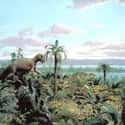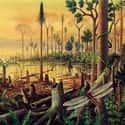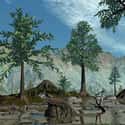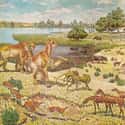-
(#2) Cambrian - From 543 - 490Ma
As you may have already figured out, 'pre' usually comes before something, and in this case, the Precambrian came before the Cambrian.
This was a time when most of the major groups of animals first appear in the fossil record. This event is sometimes called the "Cambrian Explosion", because of the relatively short time over which this diversity of life forms 'exploded'. Once the Earth hit on oxygen as a concept and a party theme, the ball really got rolling.
At least, it was rolling in the oceans... the land was completely barren, which makes sense if you think about the fact that dirt as we know it is the product of billions of years of erosion, and Earth hadn't had that kind of time to make any yet. It basically had a microbial 'crud' that acted as a soil crust covering the land. Apart from some minor evidence that a few animals might have made land, the new continents (which had just formed during the breakup of the supercontinent Pannotia) resembled deserts with shallow seas at the margins. The seas were relatively warm, and for most of this era, there was no polar ice at all. -
(#8) Triassic - From 248 to 206Ma
This period marks the end of the largest extinction event in the history of life, and is the part of the story where the shell-shocked, surviving species staggered onwards, regrouped and picked back up in the new landscape of the Triassic.
Pangaea began to break apart in the mid-Triassic, forming Gondwana (South America, Africa, India, Antarctica, and Australia) in the south and Laurasia (North America and Eurasia) in the north. The continents were well above sea level, and the sea level did not change drastically during the period. Due to this relationship, flooding of the continents to form shallow seas did not occur. Much of the inland area was isolated from the cooling and moist effects of the ocean. The result was a globally arid and dry climate (much like the Permian), though regions near the coast most likely experienced seasonal monsoons.
The ocean hosted reptiles such as the dolphin-shaped ichthyosaurs and the long-necked and paddle-finned plesiosaurs preyed on fish and ancient squid. The bottom rung of the food chain was filled with microscopic plants called phytoplankton; two of the major groups still in the oceans today first appeared.
Animal life diversified and exploded into a wide variety of creatures. Frogs, salamanders, crocodiles, turtles, and snakes emerged. Pterosaurs, a group of flying reptiles, appeared in the skies. On land you could find moss, liverwort, and ferns carpeting the floors of forests of conifers, ginkgoes, and palm-like cycads. Spiders, scorpions, millipedes, and centipedes thrived. Grasshoppers appeared.
But perhaps the biggest changes came with the evolution of dinosaurs and the first mammals in the late Triassic, starting around 230 million years ago. Another extinction event at the end of the Triassic took out a large number of these new life forms, but the Dinosaurs survived, and moved into the the most well-known period in Earth's history besides the one we occupy now.
-
(#9) Jurassic - From 206 to 144Ma
Yay, Dinosaurs! Haven't we all had enough ammonites by now? I mean, tentacles and squid faces are great and all... but I want something that can stomp other things into dust.
Land plants abounded in the Jurassic, but floras were different from what we see today. Although Jurassic dinosaurs are often drawn with palm trees, there were no palms, or any other flowering plants, at least as we know them today, in the Jurassic. Instead, ferns, ginkgoes and cycads flourished in the Jurassic. Conifers were around, including close relatives of living redwoods, cypresses, pines, and yews.
In the seas, ichthyosaurs shared the waters with the plesiosaurs and with modern-looking sharks and rays. Also prominent in the seas were cephalopods -- relatives of the squids, nautilus, and octopi of today. Jurassic cephalopods included the ammonites (more ammonites!), and the belemnites, close relatives of modern squid but with heavy, calcified, bullet-shaped, partially internal shells.
And look, scurrying in the undergrowth, no bigger than rats -- early mammals. Go mammals!
In the middle of the Jurassic, Pangea began to break apart, and by Late Jurassic the Central Atlantic Ocean was a narrow ocean separating Africa from eastern North America. Eastern Gondwana had begun to separate form Western Gondwana. Much of the Jurassic world was warm and moist, with a greenhouse climate. Although some arid regions remained, much of the rest of Pangea was lush and green. Northern (Laurasian) and southern (Gondwanan) climates were still distinct in many ways, but thanks to the connected land masses, animals had acquired a more intercontinental character. Some animals and plants were now found nearly worldwide, instead of being restricted to particular regions. -
(#6) Carboniferous - From 354 - 290Ma
One of the most important things that came out of the Carboniferous Period was the amniote egg, which allowed for the further exploitation of the land by certain verebrates. The amniote egg let the ancestors of birds, mammals, and reptiles reproduce on land by protecting the embryo in fluid, preventing it from drying out. This was also a time of larger plants and the tree-fern. Milder temperatures caused a decrease in lycopods and large insects and an increase in the number of these tree ferns. The plants from this time resemble the plants that live in tropical and mildly temperate areas today. Many of them lack growth rings, suggesting a uniform climate.
The presence of two large ice sheets at the southern pole was sucking up a huge amount of Earth's water, and because of this, the sea levels all over the world fluctuated. This led to another mass extinction, this time for shallow marine invertebrates. It also caused the gradual decline of swamps and the increase in dry land habitat.
Meanwhile, the continents were busy colliding. Laurussia (present-day Europe and North America) smashed into Godwanaland (present-day Africa and South America) and produced the Appalachian mountain belt ( I bet you never realized how much older the Appalachians were than the Rockies or the Sierras). In North America the environment was heavily marine, seas covering large parts of the continents.
-
(#5) Devonian - From 417 to 354Ma
Plants, baby. Let's get the hell out of the ocean and onto dry land... finally. The oldest known vascular plants in the Northern Hemisphere are Devonian. It was pretty much all small plants at that point, the tallest being only a meter tall, but while small, diversity was on the rise. By the end of this period, ferns, horsetails and seed plants had appeared. Devonian plants did not have roots or leaves like the plants most common today, and many had no vascular tissue at all. There were so many new plants at this time that it's called the "Devonian Explosion".
And on the animal front, two major animal groups were starting to really develop. The first land-living vertebrates appeared as did the first arthropods, including wingless insects and the earliest arachnids (yeah, bugs are OLD).
As for what the Earth itself looked like on its face, there were now three major continental masses: North America and Europe sat together near the equator, with a lot of their current land underwater. A mob continent of South America, Africa, Antarctica, India, and Australia dominated the southern hemisphere. -
(#11) Miocene - From 24 to 5Ma
While the Miocene does not technically go all the way up to where we are at now, it does, with some small differences, look just like the Earth we know today.
Early in the Miocene, temperatures begin to rise. Extensive mountain building in the Americas and Asia had altered air circulation and weather patterns and created drier overall conditions. Antarctica had frozen and the global climate had cooled again. Land bridges formed as the oceans pulled back and as inland waters dried out, new waves of animal migration between continents occurred. Grasslands expanded across the Americas and eastern Eurasia which offered plenty of food for evolving grazers like deer and antelope.
The great diversification of land mammals during the Miocene is mostly due to the formation of land bridges. These routes, which emerged as sea levels dropped and inland seas dried out, connected continents previously separated by water. The once-enormous Tethys Ocean no longer separated Africa and Eurasia. To the north, a dry corridor, the Bering land bridge, connected what are now Siberia and Alaska. At the close of the Miocene, North America and South America are close enough for some species to cross the narrow dividing waters. Australia took in animals from southeast Asia, like rodents.
And here, at last, at the very end... we have the first evidence of an upright ape with the forward-facing eyes of a predator, carrying what looks like a pointy stick who may or may not manage to find a way create its very own extinction level event.
New Random Displays Display All By Ranking
About This Tool
Scientific research shows that the earth was formed 4.6 billion years ago. From a hot magma ball, it gradually cooled and solidified, and the original ocean, atmosphere, and land appeared. The constant surface movement creates a favorable natural environment for the survival of many ancient creatures. Various life phenomena exist in different stages of earth history, deducing the magnificent history of interaction between nature and life.
Do you want to learn more about the evolution of the earth? The random tool introduced 11 easy steps of the earth's history, and you can also find interesting pictures here. Landform changes, life phenomena, and life activities together constitute the history of the earth.
Our data comes from Ranker, If you want to participate in the ranking of items displayed on this page, please click here.
















